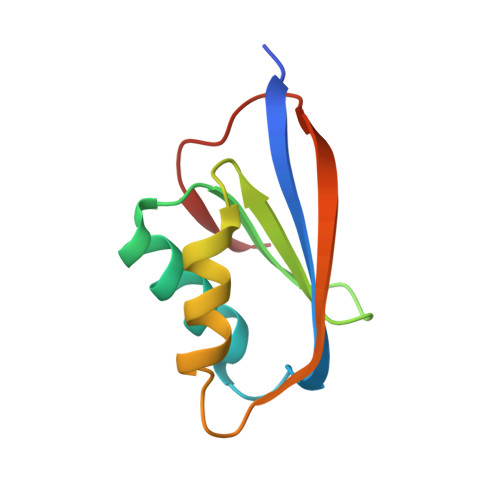Crystal Structure and Anion Binding in the Prokaryotic Hydrogenase Maturation Factor Hypf Acylphosphatase-Like Domain
Rosano, C., Zuccotti, S., Bucciantini, M., Stefani, M., Ramponi, G., Bolognesi, M.(2002) J Mol Biol 321: 785
- PubMed: 12206761
- DOI: https://doi.org/10.1016/s0022-2836(02)00713-1
- Primary Citation of Related Structures:
1GXT, 1GXU - PubMed Abstract:
[NiFe]-hydrogenases require a set of complementary and regulatory proteins for correct folding and maturation processes. One of the essential regulatory proteins, HypF (82kDa) contains a N-terminal acylphosphatase (ACT)-like domain, a sequence motif shared with enzymes catalyzing O-carbamoylation, and two zinc finger motifs similar to those found in the DnaJ chaperone. The HypF acylphosphatase domain is thought to support the conversion of carbamoylphosphate into CO and CN(-), promoting coordination of these ligands to the hydrogenase metal cluster. It has been shown recently that the HypF N-terminal domain can aggregate in vitro to yield fibrils matching those formed by proteins linked to amyloid diseases. The 1.27A resolution HypF acylphosphatase domain crystal structure (residues 1-91; R-factor 13.1%) shows a domain fold of betaalphabetabetaalphabeta topology, as observed in mammalian acylphosphatases specifically catalyzing the hydrolysis of the carboxyl-phosphate bonds in acylphosphates. The HypF N-terminal domain can be assigned to the ferredoxin structural superfamily, to which RNA-binding domains of small nuclear ribonucleoproteins and some metallochaperone proteins belong. Additionally, the HypF N-terminal domain displays an intriguing structural relationship to the recently discovered ACT domains. The structures of different HypF acylphosphatase domain complexes show a phosphate binding cradle comparable to the P-loop observed in unrelated phosphatase families. On the basis of the catalytic mechanism proposed for acylphosphatases, whereby residues Arg23 and Asn41 would support substrate orientation and the nucleophilic attack of a water molecule on the phosphate group, fine structural features of the HypF N-terminal domain putative active site region may account for the lack of acylphosphatase activity observed for the expressed domain. The crystallographic analyses here reported were undertaken to shed light on the molecular bases of inactivity, folding, misfolding and aggregation of the HypF N-terminal acylphosphatase domain.
Organizational Affiliation:
National Institute for Cancer Research, (IST) Largo R. Benzi, 10, I-16132 Genova, Italy.

















